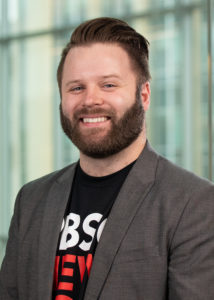
PBS Wisconsin Education Producer Ryan Hendricks
Over the past year, PBS Wisconsin Education and the Wisconsin School Music Association (WSMA) have partnered with music educators to create a collection of classroom media resources featuring Wisconsin musicians from four distinct cultural groups, as they share a composition and discuss their musicianship, culture and identity.
Released this past August, Re/sound: Songs of Wisconsin is a multimedia resource designed to help general music educators and learners in grades 4-8 explore the connections between music, culture and emotion. The collection includes video interviews and performances; audio tracks; and educator engagement guides featuring learning outcomes, strategies, assessments and aligned standards.
We sat down with one of the project’s producers, Ryan Hendricks, to learn more about how the collection came together. Re/sound: Songs of Wisconsin is available for free at pbswisconsineducation.org/resound.
Read on to learn more!
PBS Wisconsin: Tell me about Re/sound: Songs of Wisconsin and how you came to work on it?
Ryan Hendricks: Focusing on grades 4-8, Re/sound is a multimedia collection that includes video interviews with Wisconsin musicians, performances, audio files and educator engagement guides designed to help activate the media with learners. I along with my co-producer, Mia Forslund, were tasked to fill a need requested by music educators. That need was for current, authentic, culturally diverse resources, as well as support in teaching with and about music from different cultures.
How were the featured musicians chosen?
Our production team worked closely with a group of educator advisors who were connected with many musicians around the state. We explored personal connections, external recommendations and eventually landed on an incredibly talented array of musicians.
Did you know any of the artists before working on this project?
I was completely unaware of the artists prior to the work on this project, which made the discovery of their music so much more exciting for me. I think that aided our production process in a way where we could put ourselves in the shoes of the student audience, asking ourselves how we might want to be introduced to a musician and/or culture we’re unfamiliar with.
Can you tell me a little about the production process?
A major theme of this project is identity, so it was important for us to capture the musicians in places that helped the audience understand who these musicians really are. We didn’t want to just present these artists as performers, but as unique individuals who have an interesting, personal story to tell. So for each musician we traveled to locations where they’re most comfortable and where they create their music. The physical locations of the musicians help form their identity, and we can see that identity weave its way into the music we’re hearing. We also included videos of the musicians performing in various music venues. We wanted to give the musicians a chance to showcase their talent and allow our audience to focus solely on the music, which gives some flexibility and variety for the music educators who will be using the resource.
What is your goal for the students who use this resource?
The goal of the project is for students to explore connections between music, identities, cultures and emotions while recognizing shared and unique elements of distinct pieces of music. We also would like students to reflect on what they’re watching and hearing so they can relate the content to personal experiences, musical or otherwise. I hope a student will walk away from this resource with a larger musical worldview and a desire for self-exploration.
 Passport
Passport






What do you think?
I would love to get your thoughts, suggestions, and questions in the comments below. Thanks for sharing!
Ian Lewitz